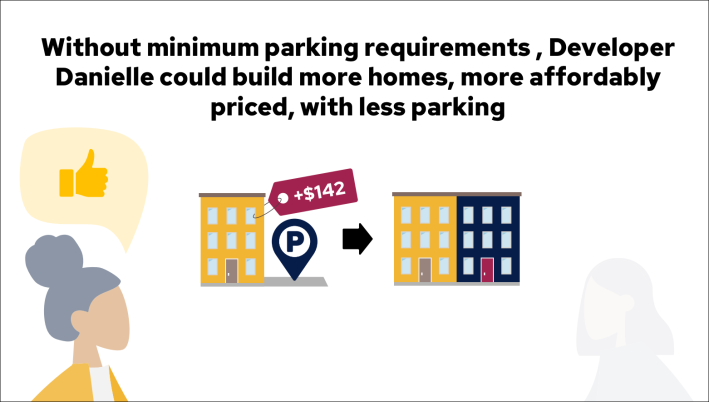The Twin Cities' victory over mandatory parking minimums was won by smart, persistent organizing among advocates and well-informed electeds — and other large U.S. communities should be bold in considering similar policies, the architects of the reform say.
In a 6-1 city council vote, the city of St. Paul said it would "fully eliminate off-street parking minimums for real estate developments ... modernizing [their] zoning codes and aligning them with best practices for land use while reducing administrative burdens for small businesses and developers."
That seismic shift came on the heels of a similar announcement from sister city Minneapolis, whose own council unanimously voted in May to stop subsidizing the storage of private automobiles. The city had previously identified parking minimums as a barrier to achieving is goal of reducing greenhouse gas emissions 80 percent by 2040 and committed to eliminating them at some point, but did not actually enact the ban city-wide until now.
We should be next, @CityofDetroit, @DetroitPlanning!! This gives small-mid size developers a chance to build. Also, surface parking tears up the fabric of the city. https://t.co/H4zMeZPxlx
— Detroit: American City (@DETAmericanCity) August 30, 2021
With a combined population of nearly 725,000, the Twin Cities region is now the largest metro in the U.S. to introduce the progressive reform. The smaller communities of Buffalo and Hartford both made the move in 2017, and hundreds of other smaller municipalities have eliminated minimums in designated districts.
Here are four lessons on how they did it, from some of the advocates and city officials who were most instrumental in the effort.
Make parking policy personal
The residents of the Twin Cities didn't simply wake up one day and decide that parking minimums needed to go. Instead, they were convinced by advocates that parking reform could be a useful tool in accomplishing a range of other community goals — especially when it came to ending climate change.
"You can approach parking reform from so many angles," said Chris Meyer, an early proponent of the issue in the region. "Historic preservationists connect with it because of how it creates neighborhood character, affordable housing proponents like to talk about how it increases the housing supply, conservatives can make a market case for it...But in central cities like ours, the best angle to target is climate."
Meyer was among the many Twin Cities advocates who recognized that the region's greenhouse gas reduction goals simply couldn't be met without addressing how free and cheap car storage incentivizes driving. With the help of then-council aide (now-Rep.) Ilhan Omar, he helped the 13 members of the Minneapolis City council to make that connection in 2015 when he gifted each of them a copy of Donald Shoup's seminal book The High Cost of Free Parking — an easy self-described "stunt" that he encourages other advocates to borrow in their own towns.
(If your region's campaign finance laws restricts you from giving gifts to candidates, Meyer recommends making yours to the council person's office, rather than the elected him, her, or themself.)
The man @DonaldShoup himself posted this on FB, including this photo of someone you all may know. Incredible praxis https://t.co/c9O2UNlJVJ pic.twitter.com/GRzKhEsSxj
— Jordan Fraade (@schadenfraade) February 13, 2021
Organize, organize, organize
Meyer's Shoup stunt paid off, but achieving parking reform at scale had to wait.
After Minneapolis eliminated parking requirements in less-than-50-unit buildings within a half-mile radius of transit stations, advocates set their sights on a more far-reaching ban, this time leveraging an upcoming election to encourage candidates to put parking reform on their platforms.
Meyer himself was eventually elected to the Parks and Recreation board, which lead to a spot on the local planning commission, too. But he stresses that any advocate can use the campaign cycle to help propel big changes, whether or not she runs for office herself; the candidates he helped lobby as an election delegate, for instance, were instrumental in getting parking reform included in the city's far-reaching climate action plan, Minneapolis 2040.
"The difference between 2015 and what we did in May is kind of like the difference between civil unions and marriage equality," jokes Meyer. "We have enough transit in Minneapolis that most of the most substantial effects of [the policy] were already in place the first time around, but it still wasn’t good enough. We really wanted to establish the principle that we should not force people to build auto infrastructure against their will — period."
Point to other cities' success
Minneapolis's incremental progress was frustrating, but it was progress — and in the meantime, it inspired its sister city speed up its own efforts.
St. Paul's own parking reform advocates were quick to encourage their own electeds to follow the Mini-Apple's lead and expand exemptions for parking requirements beyond the areas adjacent to city's famous Green Line light rail stations, where the city had already eliminated minimums roughly a decade before.
City leaders say that policy succeeded in reducing parking at projects in that region almost 30 percent while encouraging a flurry of new development, but leaders had dragged their feet on instituting wider reforms.
The Green Line light rail in St. Paul, MN is brining new development along the corridor, like an 8 city block mixed-use development replacing big box stores around the new @allianzfield. https://t.co/PQpHOwy0BA pic.twitter.com/4MFQqssCvF
— Smart Growth America (@SmartGrowthUSA) May 3, 2019
"It got to the point where almost every new development outside the Green Line seemed to be coming at us with one parking variance or another," said Nathaniel Hood, a planning commissioner for St. Paul. "We're talking about, for instance, under-funded daycares that were being forced to provide 28 parking spots for a staff of 12 people. ... It felt so onerous to have to deal with this every single time, and eventually the city council just said, 'If we don’t build a single new parking spot for the next five years, we’ll still have an tremendous amount...This policy isn't doing us any good.'"

Once it became clear that the Mini-Apple was on track to eliminate minimums completely, St. Paul raced to catch up. Staffers for the Brooklyn of the High Plains prepared themselves for a fight (including an adorable and persuasive slideshow), but found local leaders to be more receptive than they'd anticipated.
"We initially had two proposals [for parking reform], one of which was more gradual, but once Minneapolis said explicitly that they were going to eliminate minimums, we were pretty much directed to do what they'd done," said Tony Johnson, Senior City Planner for St. Paul. "That was a big change from the horror story we'd heard [a decade ago], when people thought everyone would just stop building parking entirely [along the Green Line], which would just shut the conversation down."
'Just do it'
With not one, but two major U.S. cities now free of parking minimums, Twin Cities leaders say their peers across the country have no excuse not to do the same — and if the Minnesotans' experience is any indication, it might be more painless than they'd assume.
"[When we eliminated parking minimums], a lot of people were like, 'Wow, New York City hasn’t even done this, and we’ve done it here!" said St. Paul Council Member and car-free commuter Mitra Jalali, who local advocates widely credit with getting her colleagues on board with the policy. "But the truth is, there was strangely little opposition to this. Sure, we had a few misinformed op-eds whose authors didn't understand what was actually being proposed...but we [also had] advocates — who tended to be younger and more diverse than the average meeting-goer, by the way — who came to public meetings and talked about this over and over again."
Jalali stresses that while ending parking minimums can have a huge impact on transportation, housing, community safety, and more, they don't actually prevent developers from building parking if they wish to — which means the reform should be a low bar to clear. And in an age of accelerating climate change, even small changes like this should be an ethical mandate for city leaders — because over time, they add up.
"I just think that people in roles like mine need to realize that in this moment in the arc of human history, you’re the one who can do something like ending parking minimums — and if you don’t do it, it will not get done," added Jalali."Cities should just do this. Just do it! It really can be that simple."






